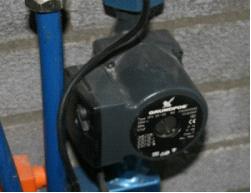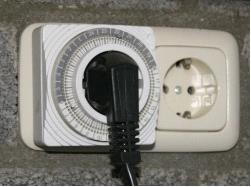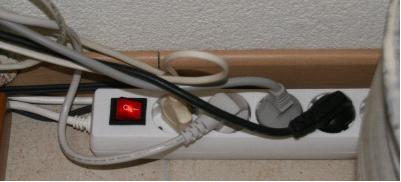The columns on this site inspired me to look at my energy consumption at home. Out of curiosity, I wondered whether I was throwing away money. I found out I was. It seems that with some simple actions, I am able to save 175 € per year…

I am one of those persons that travels half of our country to find something for 50 € cheaper. While I could also save these 50 € in a different way, not to mention the travel costs I would have while travelling… It seems many people have this weird way of saving money. With this article I want to show you that you can easily earn some money in your very own home.
Three Projects
A check on my own house resulted in three projects:
- Hidden electricity usage and users. You know these: standby usage, power supplies, pumps, etc.
- Illumination: in another article I will describe changing my halogen lamp into an energy saving lamp (going from 180 W to 9 W)
- Using a laptop as server: a laptop uses much less than a desktop computer
In a number of articles to follow, I will elaborate how the projects were done. This article is about the hidden electricity usage and users at home. The first requisite is to purchase a power meter. These is available from an electronics store, and it shows you the amount of power in Ws that is consumed by the device attached to it.

The Power Meter
Project 1 approach:
- Measure the power usage from all existing power outlets at home
- See whether the consumption can be reduced, starting from the highest consumers
An Overview of Some of the Measurement Results:
| Nr | Energy Consumer | Nominal standy usage | On-time |
|---|---|---|---|
| 1 | Floor heating circulation pump | 80 W | 24/7 |
| 2 | PC1, printer, LCD monitor | 13 W (standby) | 24/7 |
| 3 | PC2, speakers, monitor | 13 W (standby) | 24/7 |
| 4 | HDD DVD recorder | 12 W (standby) | 24/7 |
| 5 | ‘old‘ DVD player | 9 W (standby) | 24/7 |
| 6 | Subwoofer | 7 W (standby) | 24/7 |
| 7 | 2 Electrical beds | 8 W (4 W each) | 24/7 |
Floor Heating Circulation Pump
The function of this device is to circulate the water that flows through the tubes of the floor heating system. It works 24/7, however there are many periods of time the heat is not needed. So a continuously functioning pump at 80 W will lead to 700 kWh on yearly basis. A more close investigation of the pump learned that the pump could be set at 35, 55 and 80W, where the pump’s default was 80 W…

A hot water circulation pump which is always on, unnecessarily consuming energy
An installation expert once told me that the pump needs to turn since it it better to not have still-standing water in the tubes. Asking further, I learned that one hour running per day is sufficient. For my floor surface, in which (85m<sup>2</sup>) I might need the 80 W, and as I am not an expert in this, I left the 80 W setting as it was.
An easy saver was to put a power timer switch between the pump and the power, in order to switch on the pump between my heating from 7 am and 10 pm. This means the pump is turned off for 9 hours per day, resulting in an average power usage of 50 W during the day.
Further saving can be obtained by putting the pump in the summer and parts of autumn and spring at a lower power setting during one hour, for instance at 55 W. So, for half a year, I have the pump then running at 1/24 * 55 = 2.3 W on average per day.
So over the year the average becomes (50 + 2.3) / 2 = 26.2 W.
The application of a power timer switch on the heat water circulation pump can save a continuous 53.8 W, which is a yearly saver of 471 kWh.

With a power timer switch one can save a lot of money easily.
2 PCs with printers etc
We all know that electronic devices still consume electricity when in standby state. We probably don’t all know how much. The power unit of an LCD monitor + printer + PC is 13 W in total. I have two PC sets at home. The other set consists of a PC + speakerset + CRT monitor. (An interesting detail is that the CRT consumes twice as much as the LCD, when on).
I was able to remove the standby usage by using a switch-able power extender.

A power extender with switch to remove standby power consumption
This requires some discipline, but will save some energy. Assume that the PCs are on for 50 % of their time. Then the standby mode would be on 12 hours per day. And as I switch them off, it will mean a 13 W for 12 hours saving per PC setup.
This means on a yearly basis 57 kWh.
DVD players, subwoofers and others
The consumption of standby power of these consumers can be reduced considerably by making these switchable.
Look at a DVD player. When in standby mode, these players were warm to the touch! I have two of these and both of them consumed 21 W continuous standby power. So look at some of your DVD players that are almost never used anymore, remove the power cord from the power outlet when not used.
The subwoofer I use has a switch at the back that I can find easily nowadays…
Summary
The story above serves to give an insight into the standby use of quite a few electrical consumers, while these are not ‘doing’ anything. Simply by removing the connection to the power outlet (when not often used) or by using a power timer switch (when considerable amount of power is used) you can save on power used. Complete removal from the power source also enhances safety by reducing the chance that these consumers might catch fire (due to dust buildup or a failing component etc), which is also to be considered when leaving home for a long holiday.
Some hard measurement data for standy consumption of consumers in my home:
| Nr | Consumer | Saving | Remarks |
|---|---|---|---|
| 1 | Floor water circulation pump | 80-26=54 W | |
| 2 | PC1, printer, LCD monitor | 6.5 W | off for 50% of the time |
| 3 | PC2, speakers, monitor | 6.5 W | off for 50% of the time |
| 4 | HDD DVD recorder | 6 W | off for 50% of the time |
| 5 | ‘old’ DVD player | 9 W | Almost never on anymore |
| 6 | Subwoofer | 6 W | Almost never on anymore |
| 7 | 2 electrical beds | 7 W (4 W each) | Almost never on anymore |
| Total | 95 W | ||
Total yearly saving: 95W x 24h x 365 = 832.2 kWh x 0.21 € is about 175 € per year.
I would advise everyone to buy a power consumption meter and check the consumers in your house.





3 replies on “Energy Saving Projects at Home”
Thank you for your interesting article. If nothing else, the high cost of energy consumption alone would motivate most of us to follow your recommendations. Is it difficult to find a power consumption meter? What kind of place did you purchase it from? and how much did it cost?
You can find such a meter on Amazone around $24.
Do you mean Amazon.com? Thanks! I might also try ebay.